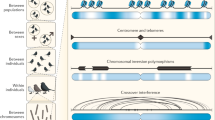Abstract
Conversion control factors (ccfs) are widespread. They control conversion properties at their target loci, affecting the conversion frequency and the amount and even the direction of gene conversion disparity. Three major types of ccf can be recognised. Experimental studies of the effects of ccfs have been combined with theoretical studies and modelling to examine the effects of ccfs on the evolutionary population genetics of alleles at the target locus. The ccf alleles present can greatly affect the rate and the direction of conversion-induced changes in target locus allele frequencies. Gene conversion can both cause and remedy linkage disequilibrium, with causation being related to polymorphismfor ccfs. Disparity in conversion direction does not by itself necessarily cause linkage disequilibrium.
Similar content being viewed by others
References
Carpenter, A. T. C., 1984. Meiotic roles of crossing-over and gene conversion. Cold Spring Harbor Symp. quant. Biol. 49: 23–29.
Catcheside, D. E. A., 1981. Genes in Neurospora that suppress recombination when they are heterozygous. Genetics 98: 55–76.
Catcheside, D. G., 1977. The genetics of recombination. Edward Arnold, London.
Chovnick, A., Ballantyne, G. H. & Holm, D. G., 1971. Studies on gene conversion and its relationship to linked exchange in Drosophila melanogaster. Genetics 69: 197–209.
Crow, J. F., 1986. Basic concepts in population, quantitative, and evolutionary genetics. W. H. Freeman, New York.
Freeling, M., 1978. Allelic variation at the level of intragenic recombination. Genetics 89: 211–224.
Ghikas, A. & Lamb, B. C., 1977. The detection, in unordered octads, of 6+:2m and 2+:6m ratios with postmeiotic segregation, and of aberrant 4:4s, and their use in corresponding-site interference studies. Genet. Res. 29: 267–278.
Girard, J. & Rossignol, J-L., 1974. The suppression of gene conversion and intragenic crossing over in Ascobolus immersus: evidence for modifiers acting in the heterozygous state. Genetics 76: 221–243.
Gutz, H., 1971. Site specific induction of gene conversion in Schizosacchaomyces pombe. Genetics 69: 317–337.
Helmi, S., 1980. Genetic controls and the mechanism of gene conversion in Ascobolus immersus. Ph.D. Thesis, Imperial College, University of London.
Helmi, S. & Lamb, B. C., 1983. The interactions of three widely separated loci controlling conversion properties of w locus I in Ascobolus immersus. Genetics 104: 23–40.
Howell, W. M., 1982. The identification and characterization of further genetic factors controlling gene conversion in Ascobolus immersus. Ph.D. Thesis, Imperial College, London University.
Howell, W. M. & Lamb, B. C., 1984. Two locally acting genetic controls of gene conversion, ccf-5 and ccf-6, in Ascobolus immersus. Genet. Res. 43: 107–121.
Katy, N. S. O. & Moore, D., 1980. Characterization of genes which influence allelic recombination in Coprinus cinerea. Curr. Genet. 1: 103–112.
Lamb, B. C., 1984. The properties of meiotic gene conversion important in its effects on evolution. Heredity 53: 113–138.
Lamb, B. C., 1985. The relative importance of meiotic gene conversion, selection and mutation pressure, in population genetics and evolution. Genetica 67: 39–49.
Lamb, B. C., 1986. Gene conversion disparity: factors influencing its direction and extent, with tests of assumptions and predictions in its evolutionary effects. Genetics 114: 611–632.
Lamb, B. C., 1988. The molecular origins of gene conversion disparity, and parameter interactions controlling its extent. Fund. Genet. (Life Sci. Adv.) 7: 109–114.
Lamb, B. C. & Ghikas, A., 1979. The intergradation, genetic interchangeability and interpretation of gene conversion spectrum types. Genetics 92: 49–65.
Lamb, B. C. & Helmi, S., 1978. A new type of genetic control of gene conversion, from Ascobolus immersus. Genet. Res. 32: 67–78.
Lamb, B. C. & Helmi, S., 1982. The extent to which gene conversion can change allele frequencies in populations. Genet. Res. 39: 199–217.
MacDonald, M. V. & Whitehouse, H. L. K., 1979. A buff spore colour mutant in Sordaria brevicollis showing high frequency conversion. I. Characteristics of the mutant. Genet. Res. 34: 87–119.
MacDonald, M. V. & Whitehouse, H. L. K., 1983. A buff spore colour mutant in Sordaria brevicollis showing highfrequency conversion. 2. Loss of the high-frequency conversion. Genet. Res. 41: 155–163.
Nagylaki, T., 1983a. Evolution of a large population under gene conversion. Proc. natn. Acad. Sci. U.S.A. 80: 5941–5945.
Nagylaki, T., 1983b. Evolution of a finite population under gene conversion. Proc. natn. Acad. Sci. U.S.A. 80: 6278–6281.
Ohta, T. & Dover, G. A., 1984. The cohesive population genetics of molecular drive. Genetics 108: 501–521.
Slatkin, M., 1986. Interchromosomal blased gene conversion, mutation and selection in a multigene family. Genetics 112: 681–698.
Stamberg, J. & Koltin, Y., 1974. Recombinational analysis of mutations at an incompatibility locus of Schizophyllum. Molec. gen. Genet. 139: 45–50.
Walsh, J. B., 1983. Role of biased gene conversion in onelocus neutral theory and genomic evolution. Genetics 105: 461–468.
Walsh, J. B., 1988. Unusual behaviour of linkage disequilibrium in two-locus gene conversion models. Genet. Res. 51: 55–58.
Wickramaratne, M. R. T. & Lamb, B. C., 1978. The estimation in Ascobolus immersus. Molec. gen. Genet. 159: 63–73.
Yu-Sun, C. C. C., 1964. Nutritional studies of Ascobolus immersus. Amer. J. Bot. 51: 231–237.
Author information
Authors and Affiliations
Rights and permissions
About this article
Cite this article
Lamb, B.C., Helmi, S. The effects of gene conversion control factors on conversion-induced changes in allele frequencies in populations and on linkage disequilibrium. Genetica 79, 167–181 (1989). https://doi.org/10.1007/BF00121510
Received:
Accepted:
Issue Date:
DOI: https://doi.org/10.1007/BF00121510



